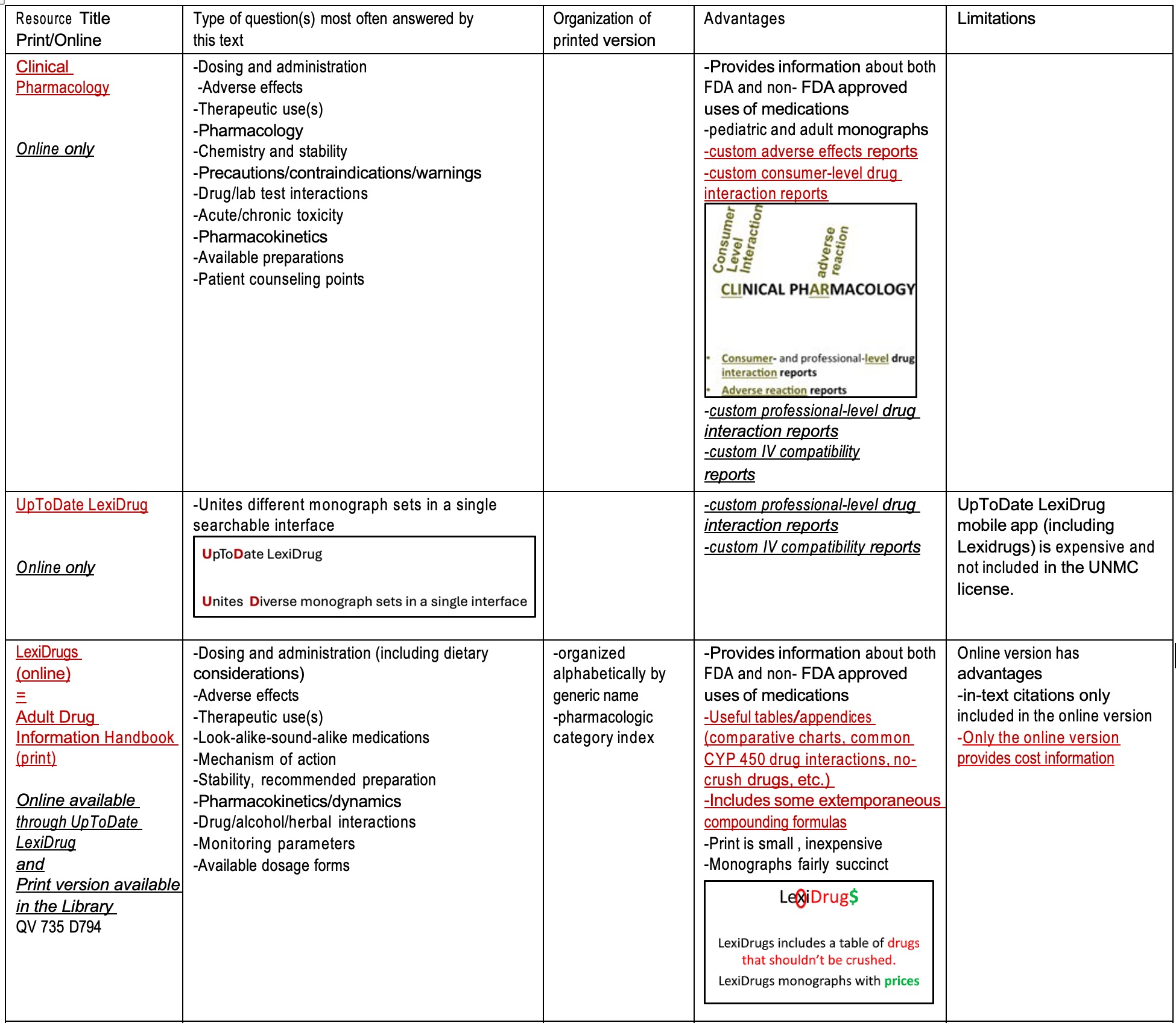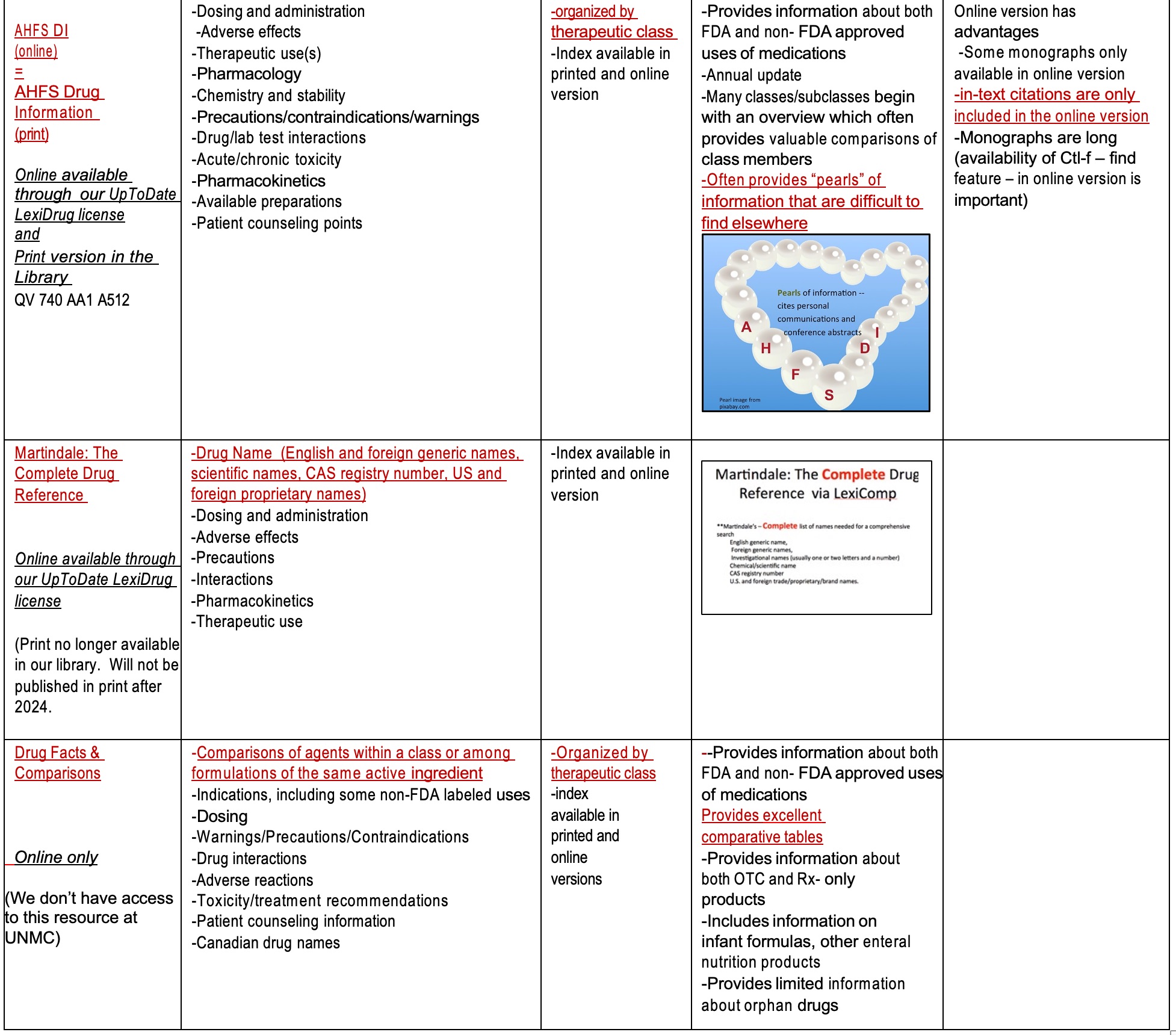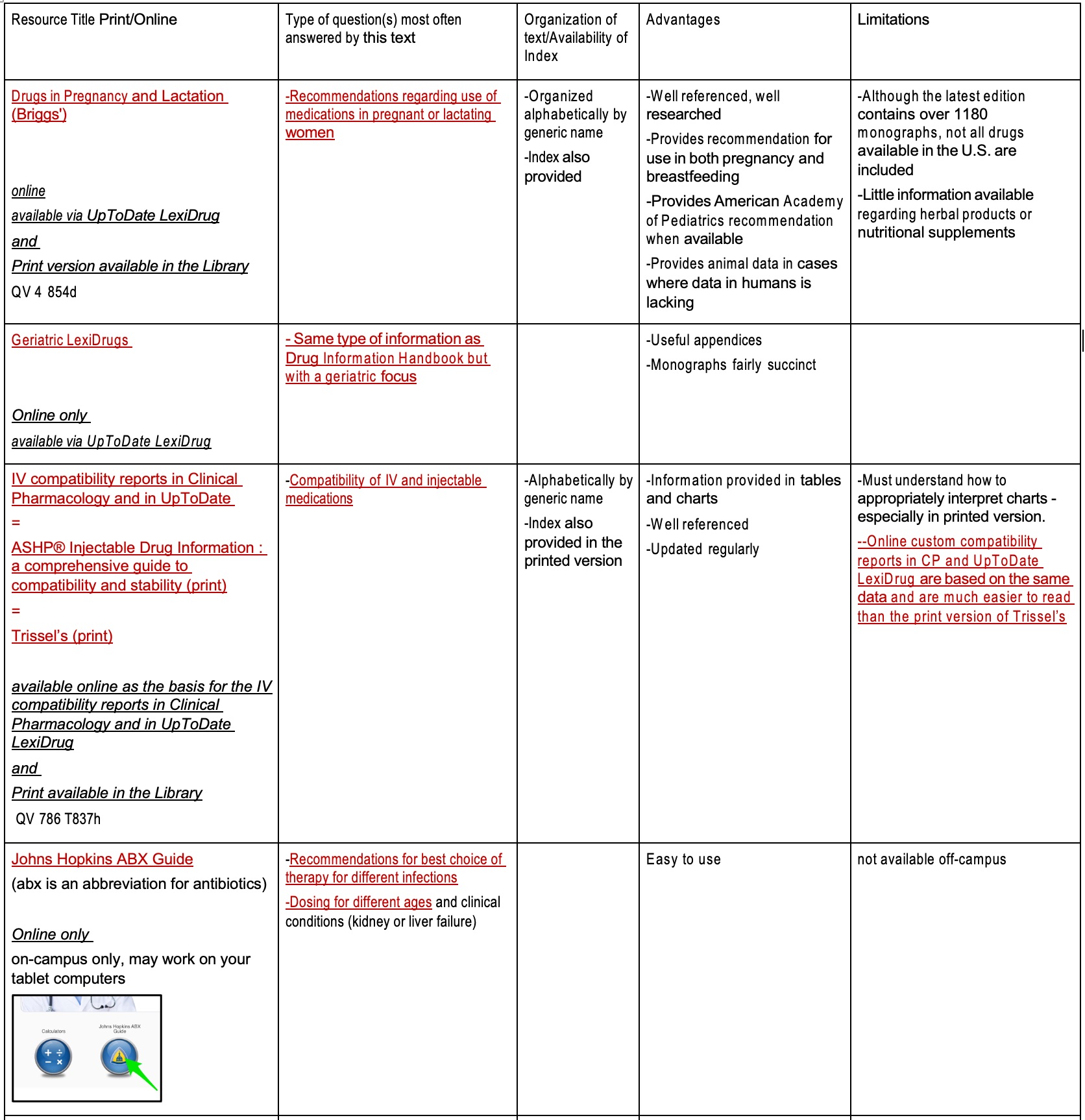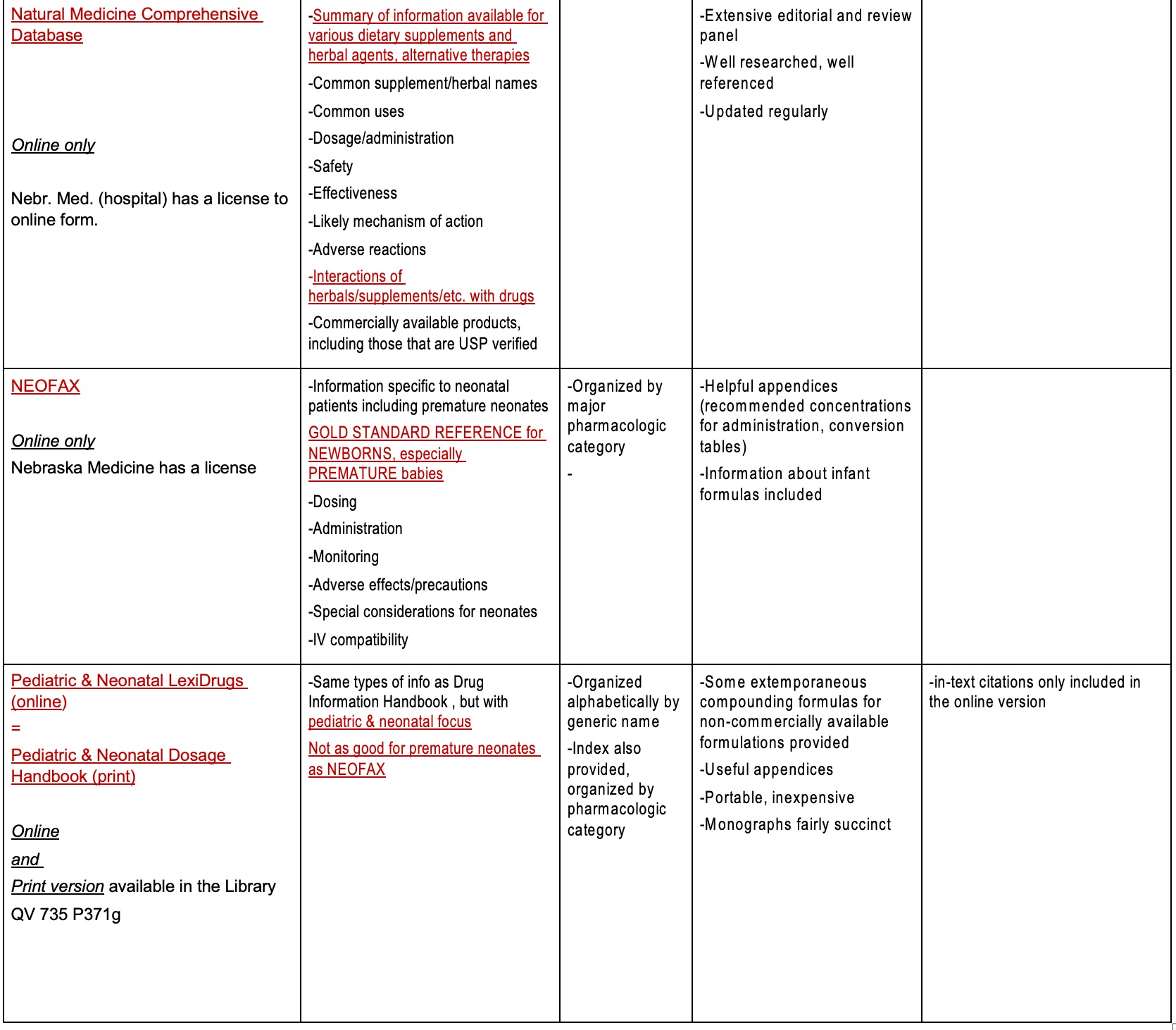Review:
I suggest that you start by completing the following review of the 5 compendia and concepts covered in the previous session. If you answer questions concerning the distinctive characteristics of the resources frequently, you will eventually have the characteristics firmly stored in your memory (and will not have to study as much for the quiz or exam).
Objectives:
- Understand the difference between primary, secondary, and tertiary resources and when each should be used.
- Be aware of the advantages and disadvantages of print vs. online tertiary resources
- Know criteria for evaluating a new tertiary resource.
- List the common tertiary references used to provide drug information daily in pharmacy practice.
- Given a request for basic drug information, locate and select the most appropriate tertiary reference for the information needed
When addressing objectives 2-4, this session will:
- provide information about the print versions of the general, online drug information compendia you’ve already used,
- will provide information about another general compendia (Drug Facts & Comparisons) only available at UNMC in print form, and
- provide information about the print and online versions of some specialty references available at UNMC.
Objective 1. Understand the difference between primary, secondary, and tertiary resources and when each should be used.
Primary Sources are original reports of research results or clinical findings
- Journal articles first reporting the results of studies or reporting individual cases.
- Conference abstracts and some conference papers
- Clinical Trial Registry records
Secondary sources help you find primary literature
- Literature databases (e.g. PubMed)
- Bibliographies (stand alone bibliographies or reference lists at the end of journal articles and book chapters, etc.)
Tertiary sources summarize primary and other tertiary literature
- General reference works like textbooks and compendia
- Point-of-Care resources like UpToDate
- Review articles published in journals and elsewhere.
When you receive a drug information question, it’s usually best to start with tertiary resources. ⭐ These summarize existing knowledge and can save you time. The best approach is, thus, to consult resources in the order shown below
- Tertiary resources should be consulted first (preferably topic-related, specialized tertiary references)
- Secondary resources (to help you locate primary literature) should be consulted if tertiary resources don’t fully answer the question
- Primary literature should generally be consulted when tertiary resources haven’t addressed a question adequately and after using secondary resources to identify the primary resources that may be useful.
Objective 2. Be aware of the advantages and disadvantages of print vs. online tertiary
Tertiary Drug Information Sources include:
- General reference books and compendia
- Specialty textbooks and compendia
Tertiary drug information sources contain information that is considered established fact
Tertiary drug information resources are often utilized for information regarding dosing, adverse reactions, drug identification, drug-drug interactions, administration, storage, background disease state information, and treatment recommendations
Many tertiary drug information resources are available in print and online, more and more are available online only
Advantages of print resources:
- a print volume is usually cheaper than a year’s license for the same resource
- available even when the internet goes down
Disadvantages of print resources:
- outdated when published
- often lack the bibliography sections that are included in online versions
- some are updated yearly, but not all
- bulky
- some are difficult to use (give the printed version of Trissell’s a try)
Advantages of online resources:
- usually updated as new information becomes available
- usually include in-text citations and bibliographies (you can find the source of the information presented).
- usually easier to use
Disadvantages of online resources:
- expensive
- often internet dependent — (Some come with installable versions for mobile devices that are still available when the internet is down).
Objective 3 – Know criteria for evaluating a new tertiary resource
Occasionally you will want to buy a book or license an online resource for yourself or for your pharmacy
When deciding whether to purchase or license a resource, consider the following:
- What are the credentials of the authors/contributors/editors?
- Is there an editorial panel?
- What year was the reference published?
- Which edition is the reference?
Books and resources that are NOT first editions may be a better bet:
-
- Online resources that have existed for many years and print resources that have many editions have survived because someone has found them useful — a good sign.
- Also, first editions often contain more errors than subsequent editions. Authors and editors sometimes miss typographical and other types of errors in any edition. Those using the resource often report the errors and the reported errors are fixed in subsequent editions.
- Does it contain a bibliography or reference list? Are the important statements referenced?
- Is the information easy to find and read?
- Does the resource appear free from bias? (Are drugs from a specific manufacturer always favored? Are new drugs favored over old drugs without any supporting evidence?)
- What is the cost of the resource?
Objective 4. List the common tertiary references used to provide drug information daily in pharmacy practice. and Objective 5. Given a request for basic drug information, locate and select the most appropriate tertiary reference for the information needed
Below are images of two tables and links that will allow you to accessible versions of these two tables. These tables list the most important drug information resources and their characteristics. You will be responsible knowing the underlined information in both tables.
Please read through the information in the tables below focusing on the underlined information. ⭐ Notice that some of the books are organized by pharmacologic or therapeutic class. These books usually contain a section that introduces the class. If you want a resource that contrasts members of a class or summarizes information applying to a whole class, these are the best resources to consult.
Table 1. General Drug Information Resources.
Key to emphasized points:
Underlined, non-italicized, red font = distinctive characteristics that will probably be covered on exams and quizzes
Underlined, italicized, black font = format information and other information that may also be covered on exams.
None of the resources listed below is limited to FDA-approved uses. In other words, all may include off-label uses. DailyMed, a resource not listed below, is the only resource we will address in this class that is limited to FDA-approved uses.
You may wish to download the table. It’s available for download using the following link: general-drug-information-resources-2025 accessible


Table 2. Specialty Drug Information Resources.
Key to emphasized points:
Underlined, non-italicized, red font = distinctive characteristics that will probably be covered on exams and quizzes
Underlined, italicized, black font = format information and other information that may also be covered on exams.
None of the resources listed below is limited to FDA-approved uses. In other words, all may include off-label uses.
You may wish to download the table. It’s available for download through the following link: specialty-Table-2025 accessible


Assignment
- Download the 8 question, 3-page student-version-tertiary-references-assignment-2025
- Complete the interactive exercise immediately below this numbered list of assignment instructions. It will help you decide which resource to use when you answer questions 1-5 in today’s assignment. When filling in the interactive blanks, use the exact spelling and capitalization shown in the list of possible answers at the beginning of the exercise. You may redo the exercise if you get an answer wrong, just refresh the webpage to start over.
- Enter the correct answers to this interactive exercise in the “Which tertiary resources should be used” spots that are the part a’s of #1-5 on your assignment sheet (student-version-tertiary-references-assignment-2024). When you have to enter both the name of a resource and the name of a portal/interface in the interactive exercise, enter both these names on the assignment sheet as well (e.g. Martindale The Complete Drug Reference through UpToDate LexiDrug).
- After completing the interactive exercise below and determining which resources should be used for #1-5 in the assignment. Go to the chosen (#1-5) or indicated (#6-7) resources, find, and enter the answers to all assignment questions.
- Save the document with your answers and submit via Canvas.
.
Questions, Problems, Text Errors?
Before you leave, …
- Do you have any questions or do you feel that clarification of some aspect of the materials would be helpful?
- Have you noticed any errors or problems with course materials that you’d like to report?
- Do you have any other comments?
If so, please, submit your questions, comments, corrections, and concerns to Cindy Schmidt (cmschmidt@unmc.edu).
.

